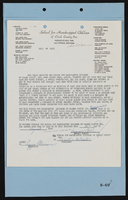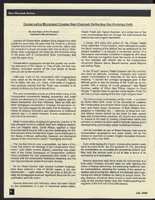Search the Special Collections and Archives Portal
Search Results
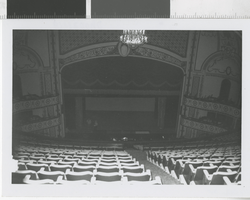
Photograph of the interior of the Shubert Theatre, Cincinnati (Ohio), 1970
Date
Archival Collection
Description
Image
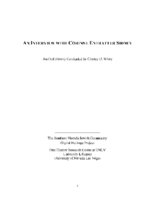
Transcript of interview with Corinne Entratter Sidney by Claytee White, June 5, 2007
Date
Archival Collection
Description
Interview with Corinne Entratter Sidney by Claytee White on June 5, 2007. In this interview, Sidney talks about growing up with privilege in California, where her father served as the attorney general. She attended school at UCLA and took acting classes and signed with United Artists. She met Jack Entratter in Los Angeles and moved to Las Vegas and worked as a Copa Girl. She discusses Jack Entratter's generosity and influence in town, and his style, and their lifestyle together. She mentions the likes of Frank Sinatra, Lena Horne and Sammy Davis, Jr. and her extravagant life living at the Sands. After Jack's death in 1971, she moved back to Los Angeles, returned to acting, and wrote a newspaper column. On a visit to Las Vegas with George Sidney after Sidney's wife Jane died, Corinne and George began dating and were married shortly after. They moved back to Las Vegas together for a slower pace. She describes her love of Las Vegas and its continued growth.
Corinne Sidney's life story makes for fascinating reading. She was born in 1937, the daughter of Alice Polk, former Ziegfeld showgirl, and Carl Kegley, an attorney. She attended U. of C. Berkeley, transferred to UCLA, and was spotted by a talent scout who convinced her to enter a Miss USA contest. Corinne's runner-up status in the Miss USA contest led to job offers in acting, so she decided to study acting. This, along with her childhood lessons in ballet, piano, singing, tap dance and horseback riding, led to a contract with United Artists, freelance work, television parts, and plays. Around the age of 18, Corinne met Jack Entratter. Their relationship brought her to Las Vegas, where she worked as a showgirl at the Sands for a few months, and where she married Jack a few years later. They lived a fabulous lifestyle which included travel, beautiful homes, and friendships with noted celebrities. Corinne went back to acting in Los Angeles after Jack passed away, but then segued into writing a gossip column and hosting a television show. She reconnected with an old friend (George Sidney) by writing the obituary for his wife, and within a few months they were married. The Sidney's moved back to Las Vegas, where Corinne still makes her home today.
Text

Marisa Rodriguez oral history interview: transcript
Date
Archival Collection
Description
Oral history interview with Marisa Rodriguez conducted by Maribel Estrada Calderón, Monserrath Hernández and Claytee D. White for the Latinx Voices of Southern Nevada Oral History Project. Marisa Rodriguez discusses her childhood and living in North Las Vegas as a teenager; she was born in Chicago, Illinois, moved to Mexico with her family at a young age, and returned to the United States at age 12. She recounts what it was like acclimating to American life, learning English, and studying abroad in Spain before becoming a law student. Marisa attended the William S. Boyd School of Law and is currently a civil litigator in Las Vegas. Subjects discussed include: La Voz Hispanic/Latino Law Students Association at the William S. Boyd School of Law; Huellas mentorship program.
Text

Transcript of interview with James M. Bonaventure by Claytee D. White, September 9, 2014
Date
Archival Collection
Description
Text
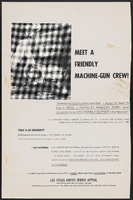
Las Vegas United Jewish Appeal "Meet A Friendly Machine-Gun Crew!" poster, 1953-1959
Date
Archival Collection
Description
Meet A Friendly Machine-Gun Crew! poster from the Las Vegas United Jewish Appeal asking for contributions to aid Jewish refugees. The text across the the front reads: "MEET A FRIENDLY MACHINE-GUN CREW! "America will lose the entire near East -- except for Israel! As long as ISRAEL is HELPED BY AMERICAN JEWRY, Israel can survive as our ONE FRIENDLY OUTPOST in the Near East!" - a statement made by General "Lightening Joe" Collins, former Chief of Staff, United States Army, at the Army and Navy Club, Washington, D.C., on July 1. 1958. TODAY IS AN EMERGENCY!! 80,000 persecuted Jewish refugees from Poland and Moslem lands must be helped to get to Israel - and quickly! Your contribution to the UNITED JEWISH APPEAL will help the emergency SPECIAL RESCUE FUND of $100,000,000 - and will help build up the newborn state of Israel - to remain strong - well-armed -- fiercely proud of its freedom - ready and able to remain YOUR ONE FRIENDLY OUTPOST IN A HOSTILE PART OF THE WORLD! -wouldn't you feel a little more secure with a friendly outpost guarding your freedom in the Near East? Las Vegas United Jewish Appeal Post Office Box 1981 Las Vegas, Nevada. Carl Cohen, chairman/Co-chairmen: Moe Dalitz and Jacob Kozloff/Nevada State Chairman: Edward Levinson"
Mixed Content
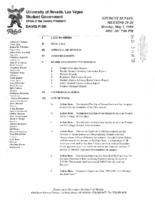
Meeting minutes for Consolidated Student Senate University of Nevada, Las Vegas, May 3, 1999
Date
Archival Collection
Description
Text

